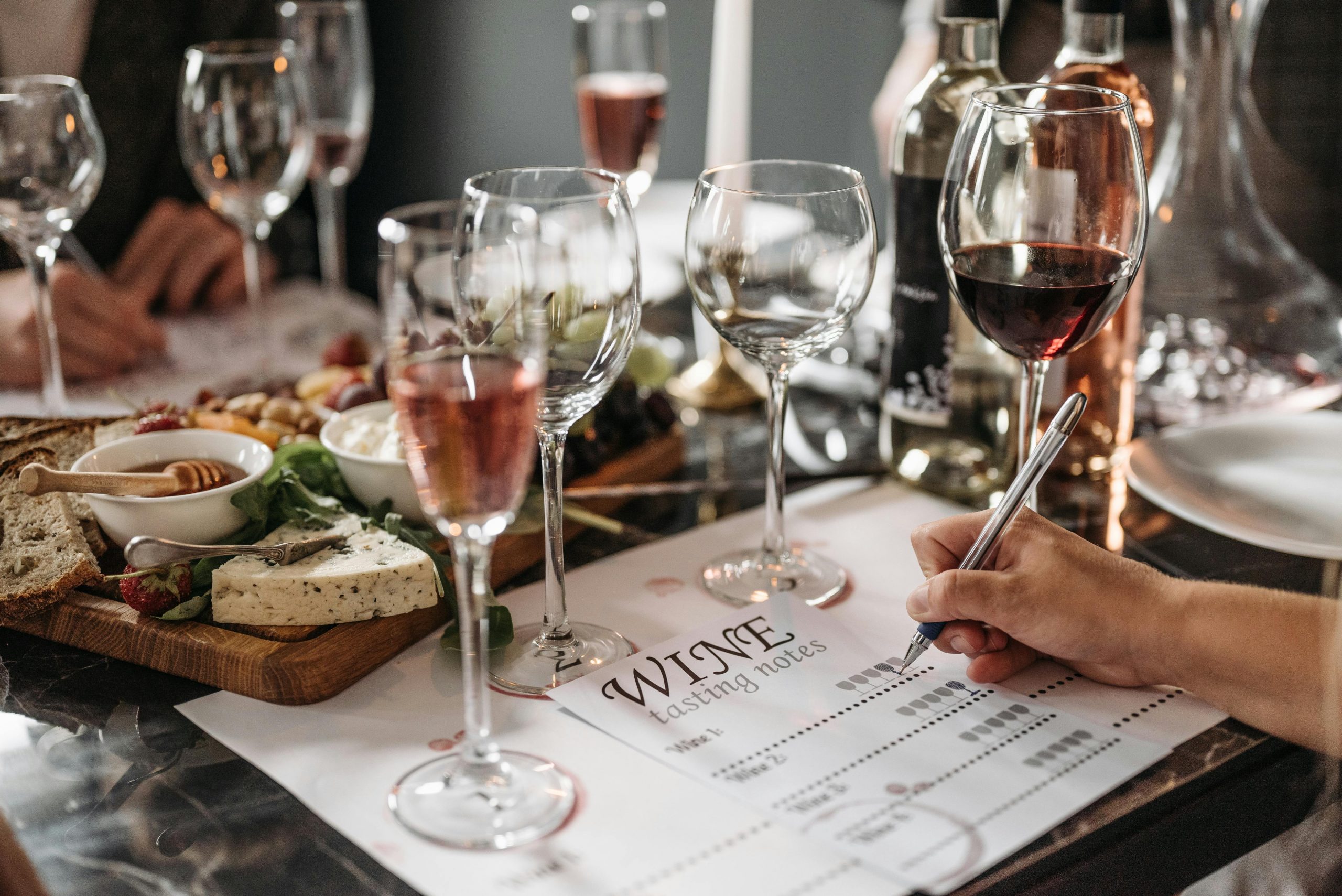Disclaimer: The World Wide Wine. This site provides food and drink content for informational purposes only.
Wine is more than just a drink — it’s a sensory experience that can transport you to a vineyard in Tuscany, a sun-drenched hillside in Napa, or a cool cellar in Bordeaux. But if you’ve ever sipped a glass and wondered, what exactly am I tasting? you’re not alone. The flavors in wine can be rich and complex, ranging from sweet and fruity to dry, earthy, or even spicy.
In this guide, we’ll break down what wine really tastes like, how to identify key flavor profiles, and how sweetness, dryness, fruitiness, tannins, acidity, and body all play a role in the experience. Whether you’re a casual sipper or a dedicated connoisseur, understanding these basics will enhance every glass you drink.
What Does Wine Taste Like? Understanding What Determines Its Flavor
Before diving into the different taste categories, it helps to understand what factors shape a wine’s flavor. These include:
- Grape variety – Each grape has its own flavor profile. Pinot Noir tastes different from Cabernet Sauvignon, and Chardonnay is nothing like Sauvignon Blanc.
- Climate and terroir – Where the grapes are grown affects the acidity, sweetness, and overall taste.
- Winemaking style – Fermentation techniques, aging methods, and even the type of barrel used influence the final flavor.
- Age of the wine – Young wines often taste fresher and fruitier; older wines can develop complex, earthy, or nutty characteristics.
What Does “Sweet” Wine Taste Like?

Sweet wines contain higher residual sugar, meaning not all the grape sugar has been converted to alcohol during fermentation.
Typical Characteristics of Sweet Wines:
- Tastes like honey, ripe fruit, or syrup
- Smooth mouthfeel, sometimes slightly viscous
- Less bite from acidity or tannins
Examples of Sweet Wines:
- Moscato – Light, fruity, and sweet with peach and apricot notes
- Riesling (Late Harvest) – Can be intensely sweet with flavors of honey, apple, and citrus
- Port and Sherry – Fortified wines with rich sweetness and warming alcohol
Sweet wines are great for dessert pairings or sipping on their own.
What Does “Dry” Wine Mean?
“Dry” is one of the most misunderstood wine terms. In wine speak, dry simply means there’s little to no residual sugar. It does not mean the wine will dry out your mouth (though tannins can do that—more on that later).
Common Traits of Dry Wines:
- Little to no sweetness
- Crisp, sharp, or bitter finish
- Often higher in tannins and/or acidity
Popular Dry Wines:
- Cabernet Sauvignon – Dry red with notes of blackberry, cedar, and green pepper
- Sauvignon Blanc – Crisp white with grassy, citrusy flavors
- Chianti – Medium-bodied red with tart cherry and earthy flavors
Dry wines often pair well with food due to their clean finish and lack of sugary residue.
Are Fruity Wines the Same as Sweet Wines?
This is a common misconception. Fruitiness does not equal sweetness.
A wine can be fruity (tasting like berries or tropical fruit) while still being completely dry. Conversely, a wine can be sweet without tasting overtly fruity.
Fruity Wines (Dry and Sweet):
- Zinfandel – Jammy red fruit flavors, often dry or semi-sweet
- Gewürztraminer – Aromatic with lychee and floral notes, can be off-dry
- Rosé – Usually fruity with strawberry or watermelon notes, ranges from dry to sweet
The presence of fruit flavors depends on the grape and how it’s made—not the sugar content.
What Are Tannins and Why Do They Matter?
If you’ve ever sipped a red wine and felt your mouth dry out, you’re experiencing tannins — naturally occurring compounds found in grape skins, seeds, and stems, as well as from oak barrels.
Tannin Characteristics:
- Astringent, drying sensation on the tongue
- Adds structure and complexity to red wines
- Helps wine age longer
High-Tannin Wines:
- Cabernet Sauvignon
- Nebbiolo (Barolo)
- Syrah/Shiraz
Low-Tannin Wines:
- Pinot Noir
- Merlot
- Gamay (Beaujolais)
Tannins often balance out rich foods and are essential for a bold, age-worthy wine.
What About Acidity in Wine?
Acidity gives wine its refreshing quality. It makes your mouth water, balances sweetness, and enhances food pairings.
Signs of High Acidity:
- Mouth-watering sensation
- Tart or citrusy taste
- Lively and fresh finish
Wines Known for High Acidity:
- Sauvignon Blanc
- Champagne
- Riesling
- Chianti
Acidity is especially important in white wines and sparkling wines. It also helps red wines age gracefully.
Light-Bodied vs Full-Bodied: How Heavy Should Wine Feel?
Wine can be light, medium, or full-bodied, a term that describes the weight and texture of the wine in your mouth — much like the difference between skim milk and whole milk.
Light-Bodied Wines:
- Easy to drink
- Lower alcohol (typically under 12.5%)
- Refreshing and crisp
Examples:
- Pinot Grigio
- Gamay
- Albariño
Full-Bodied Wines:
- Rich and bold
- Higher alcohol (13.5%+)
- Coats the mouth and lingers
Examples:
- Cabernet Sauvignon
- Chardonnay (oak-aged)
- Malbec
Understanding body helps you choose wines that suit your palate or your meal.
Flavor Notes: What Am I Tasting?

Wine flavors can span a wide range of categories. These are commonly used descriptors to help identify what you’re tasting.
Common Wine Flavor Categories:
Fruit:
- Red wine: cherry, plum, blackberry, raspberry
- White wine: apple, pear, citrus, tropical fruit
Floral:
- Rose, violet, honeysuckle, orange blossom
Spice:
- Black pepper, clove, cinnamon, anise
Earthy:
- Mushroom, forest floor, wet leaves
Oak/Aging Notes:
- Vanilla, toast, caramel, smoke
Herbal/Vegetal:
- Green bell pepper, grass, eucalyptus
Mineral:
- Slate, chalk, flint, wet stone
Tip: Swirl your glass, take a whiff, then sip slowly to identify these layers.
How Do You Describe Wine Like a Pro?
Describing wine gets easier the more you practice. Use the “Look, Smell, Taste” method:
- Look – Note the color and clarity.
- Smell – Swirl and take in the aroma (called the bouquet or nose).
- Taste – Take a small sip and think about:
- Sweetness (is it sugary?)
- Acidity (does it make you salivate?)
- Tannin (does it dry your mouth?)
- Body (is it light or full?)
- Flavor (fruity, spicy, earthy?)
Try to relate the taste to familiar foods, herbs, or experiences. Your taste memory will sharpen over time.
Does Wine Temperature Affect Taste?
Yes — temperature has a major impact on how wine tastes. Serving wine at the wrong temperature can mute flavors or make alcohol taste harsh.
General Temperature Guidelines:
- Red wine: Serve slightly below room temp (60–65°F / 16–18°C)
- White wine: Chill but don’t freeze (45–55°F / 7–13°C)
- Sparkling wine: Very cold (40–45°F / 4–7°C)
- Sweet dessert wines: Cold or slightly chilled to tame sweetness
Too warm? Alcohol becomes overpowering.
Too cold? Flavors are dull and aroma is lost.
Pro tip: Let reds breathe for 15–20 minutes before sipping, and take whites out of the fridge a few minutes before serving for the best flavor balance.
How Food Pairing Influences Wine Taste
The right food can complement or contrast wine flavors — even changing how the wine tastes.
Classic Wine + Food Pairings:
- Dry reds (Cabernet, Syrah): Perfect with grilled meats, hearty stews
- Acidic whites (Sauvignon Blanc, Pinot Grigio): Great with seafood, salads
- Sweet wines (Riesling, Moscato): Balance spicy foods or rich desserts
- Sparkling wines (Champagne, Cava): Cut through fried or salty foods
Pairing Tips:
- Match intensity – bold wines with bold dishes
- Use contrast – sweet wines tame spice; acidic wines cut through fat
- Think regional – Italian wines with Italian food, etc.
Pairings don’t need to be fancy — even wine with popcorn or cheese can elevate the experience.
What’s the Best Wine for Beginners?
If you’re just starting your wine journey, here are great beginner-friendly options:
- Moscato – Sweet, light, and easy-drinking
- Pinot Noir – Light red with soft tannins and cherry flavors
- Riesling – Ranges from dry to sweet, always aromatic
- Rosé – Refreshing and fruit-forward, perfect chilled
- Beaujolais Nouveau – A young, fruity red with minimal tannins
These wines are approachable and don’t require an advanced palate to enjoy.
How to Develop Your Wine Palate Over Time
You don’t need to be a sommelier to enjoy and describe wine like one. Developing your palate is all about exposure and practice.
Steps to Train Your Taste Buds:
- Taste side by side: Try a dry vs. sweet, or light vs. full-bodied wine to spot the differences.
- Use a flavor wheel: Wine aroma wheels help identify smells you might not name right away.
- Compare regions: A Chardonnay from California tastes different than one from France.
- Join a tasting group or class: Get feedback, learn from others, and expand your preferences.
Over time, you’ll start noticing subtle flavors like vanilla from oak aging or minerality from the soil. And best of all — you’ll learn exactly what kind of wine you love most.
Bonus Tip: Keep a Wine Tasting Journal
To develop your palate, jot down notes on each wine you try. Include:
- Name and vintage
- Grape variety and region
- Tasting notes (fruit, body, tannins, acidity)
- Your personal rating (1–10)
This habit helps you discover your preferences and makes it easier to find new wines you’ll love.
Final Sip: The Beauty of Wine Is in Its Variety
Wine can taste sweet like strawberries, dry like cedarwood, fruity like tropical punch, or earthy like mushrooms. The range is immense—and that’s the beauty of it.
There’s no “right” taste—only what you enjoy.
Whether you’re exploring bold reds, crisp whites, or bubbly sparkling wines, understanding the different components of taste helps you savor every drop. Next time you raise a glass, you’ll not only know what you’re drinking—you’ll know why it tastes the way it does.

